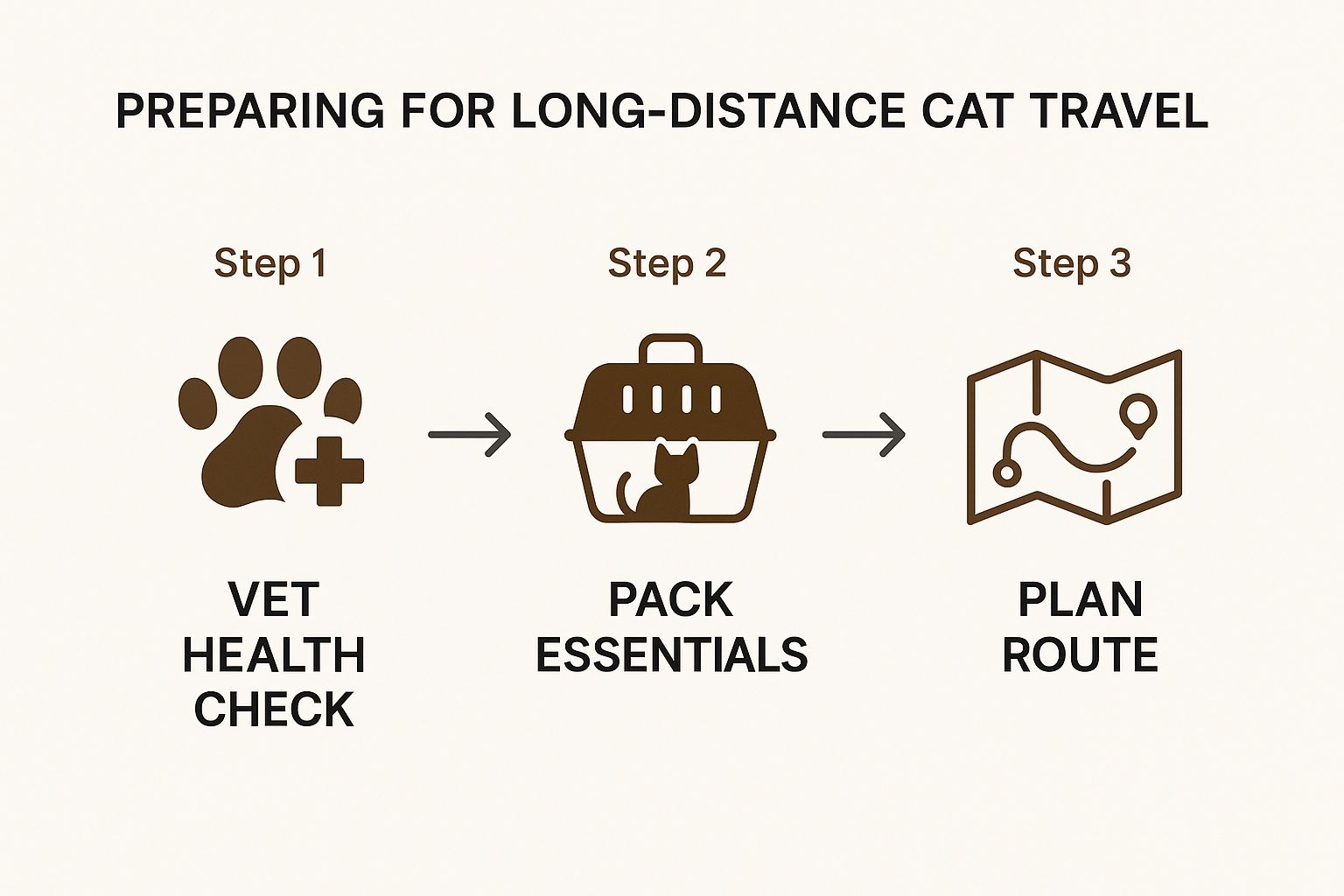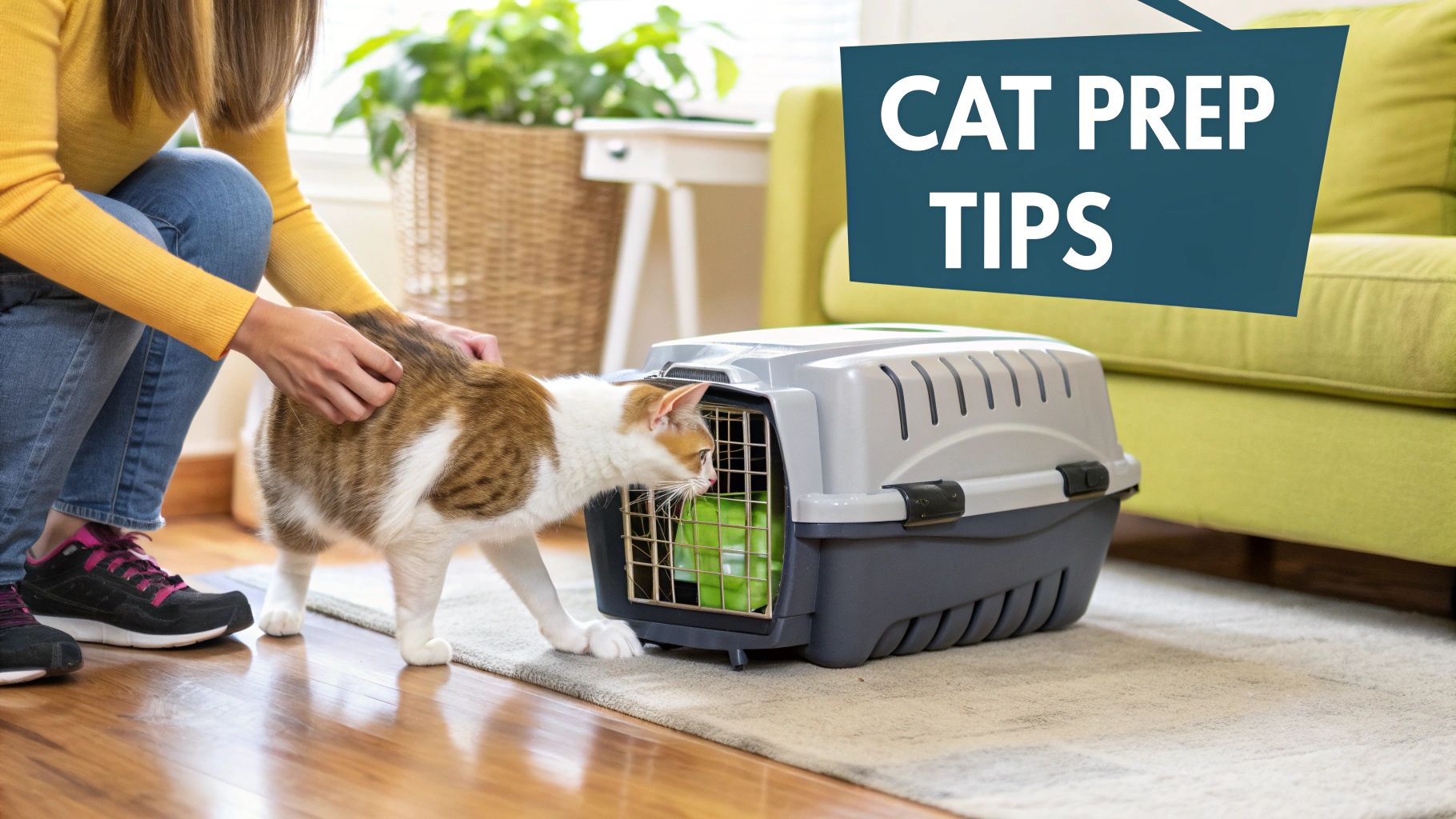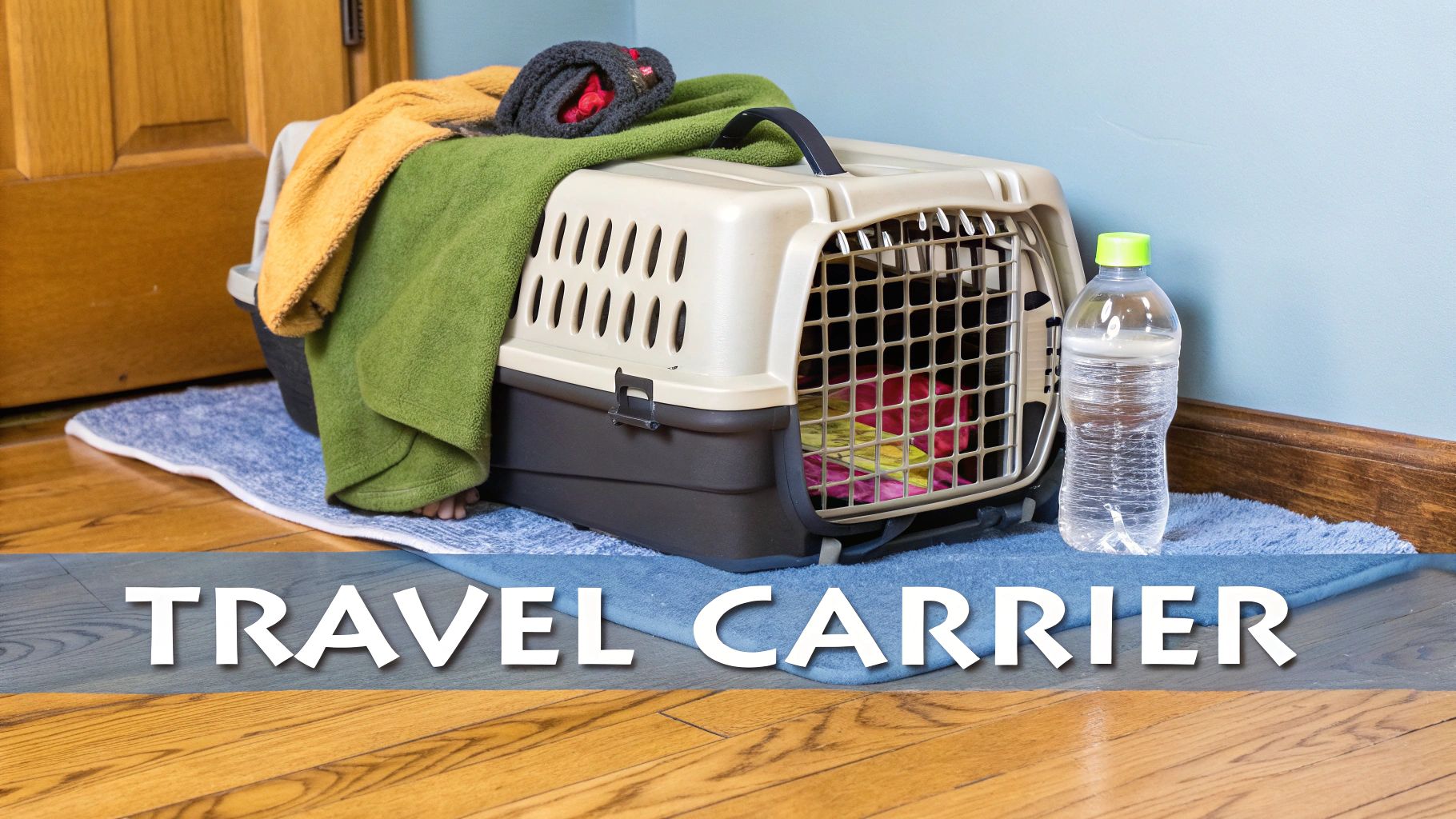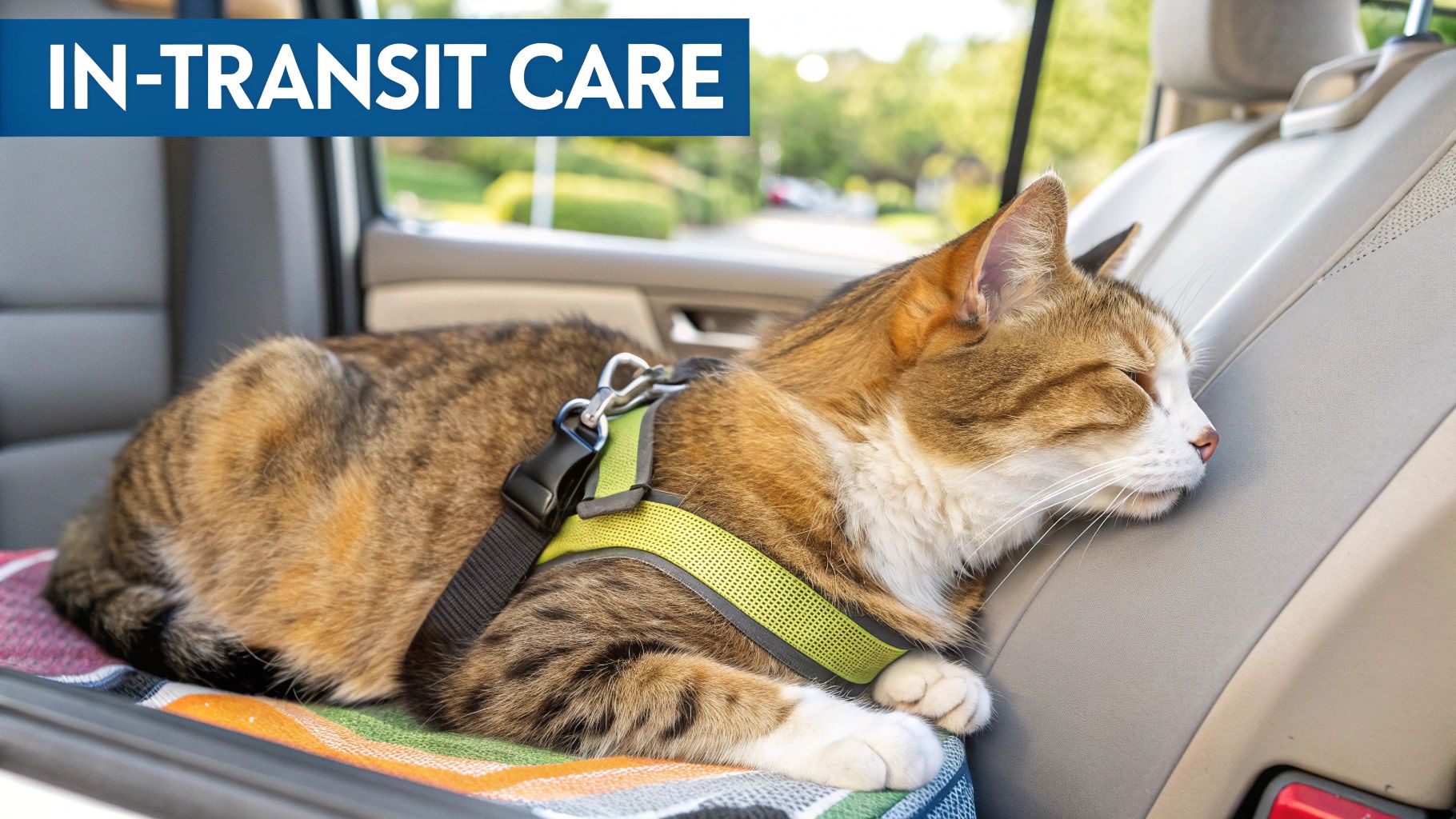The secret to a successful long-distance trip with your cat comes down to two things: great preparation and positive association. This isn't about wrestling them into the carrier on travel day. It's about laying the groundwork weeks ahead of time to turn a potentially scary event into just another day for your feline friend. Get this right, and you’re setting yourself up for a calm, manageable journey.
Building Your Pre-Trip Feline Travel Plan
A smooth ride starts long before you even see the car. Solid planning is hands-down the most critical part of traveling with a cat, turning what could be total chaos into a controlled, low-stress experience. It’s a mind shift—stop thinking about the destination for a minute and focus on the tiny details that will get your cat there safely and happily.
Your very first stop? A chat with your veterinarian. This is one step you absolutely cannot skip.
The Essential Veterinary Health Check
Book a check-up at least a few weeks before you plan to leave. Think of this as more than just a health screening; it’s a strategic planning session with a pro. This is your chance to get all vaccinations up to date and, crucially, to get any health certificates you might need. If you're flying or crossing state lines—or especially international borders—the paperwork can be surprisingly strict. You don't want your entire trip derailed because of a missing form.
Be sure to talk through your travel plans—car or plane—with the vet. They know your cat's specific health history, age, and temperament, so they can give you advice that’s actually useful. It’s also the perfect time to discuss calming aids, from pheromone sprays to prescription options. This way, you’re making an informed choice, not a desperate grab for something at the last minute.
Assembling Your Cat’s Travel Go-Bag
Got the all-clear from the vet? Great. Now it's time to pack your cat’s bag. This is their personal carry-on, stuffed with all the essentials and comforts of home to create a familiar little bubble for them on the road. A well-packed go-bag is your secret weapon for managing their needs and keeping them comfortable.
Here’s a quick rundown of what should be in that bag:
- Food and Water: Pack way more of their regular food than you think you'll need. A sudden diet change on top of travel stress is a recipe for an upset stomach, which is the last thing anyone wants to deal with in a moving car. Bring a familiar water bowl, too.
- Portable Litter Box: A travel-sized litter box and a small bag of their usual litter are absolute game-changers. This lets you offer scheduled, safe potty breaks, which keeps your cat comfortable and prevents accidents.
- Comfort Items: A favorite blanket, a t-shirt that smells like you, or a well-loved toy can make a huge difference. Those familiar scents are incredibly reassuring in a strange new environment.
- Cleaning Supplies: Don’t leave home without paper towels, pet-safe wet wipes, and a few plastic bags. You'll be grateful you have them for any quick clean-ups.
This simple visual breaks down the core steps for getting your cat road-ready.

To make things even easier, here’s a quick checklist to keep you on track.
Cat Travel Essentials Checklist
This table is your quick-glance guide to make sure you have all the essentials packed and every pre-travel task checked off.
| Category | Item or Action | Expert Tip |
|---|---|---|
| Health & Safety | Vet check-up & health certificate | Schedule this 3-4 weeks out. Some paperwork takes time to process. |
| Health & Safety | Microchip information updated | Make sure your contact info is current in the microchip database. |
| Carrier & Comfort | Comfortable, secure carrier | Choose one with good ventilation that's large enough for your cat to stand and turn around. |
| Carrier & Comfort | Favorite blanket or t-shirt | An item with your scent on it provides a powerful sense of security. |
| Food & Water | Regular cat food (extra supply) | Stick to their usual diet to prevent digestive issues. |
| Food & Water | Collapsible bowls & bottled water | Using water from home can sometimes help sensitive stomachs adjust. |
| On-the-Road Care | Travel litter box & litter | Set it up during breaks every 4-6 hours to give them an opportunity. |
| On-the-Road Care | Cleaning supplies (wipes, paper towels) | Keep this kit easily accessible, not buried in the trunk! |
Getting these foundational steps right before you go is what truly sets the stage for a positive experience. As the infographic shows, it’s a logical flow from health checks to packing familiar comforts. For a deeper dive into creating the perfect travel setup, you can check out our free pet travel guide for more detailed checklists and tips.
Turning the Carrier Into a Safe Space
For most cats, the carrier is bad news. Its sudden appearance usually means one thing: a trip to the vet. That association runs deep, and it’s the root cause of the anxiety that can turn travel day into a nightmare for both of you.
The single best thing you can do for a calm trip is to completely rebrand the carrier in your cat’s mind. Your mission is to transform it from a scary cage into a cozy, mobile den.

This isn’t a one-day job. It takes patience and should start several weeks before you even think about packing. The idea is to make the carrier so normal, so boring, that your cat stops seeing it as a threat.
Integrating the Carrier into Daily Life
First things first: get that carrier out of the closet. Place it in a high-traffic area of your home, like the living room or right next to their favorite napping spot. Prop the door wide open so it can’t accidentally swing shut and spook them. You want it to become just another piece of furniture.
Next, make it inviting. Line the inside with a super-soft blanket or an old t-shirt that smells like you. Familiar scents are incredibly reassuring for cats and go a long way in creating a sense of security.
Expert Insight: Cats are creatures of habit and incredibly territorial. By making the carrier a permanent fixture in their territory, you strip away its power. It’s no longer a scary, unknown object that appears out of nowhere; it’s just part of the landscape.
Now, let the positive associations begin. Casually toss high-value treats and their favorite toys inside throughout the day. Don't push them or try to lure them in. Just let them discover these little surprises on their own. This helps them learn, at their own pace, that good things happen in and around the carrier.
If you’re starting from scratch, finding the right carrier can make a huge difference. Check out our complete guide to airline-approved cat carriers for some great options that focus on both safety and comfort.
Taking the Training to the Next Level
Once you notice your cat willingly popping into the carrier for a treat or a snooze, you're ready to up the ante. Start feeding them their regular meals inside. At first, just put the bowl right at the entrance. As they get more comfortable, slowly push it further toward the back.
This is a game-changer. It solidifies the carrier as a rewarding, positive space. Pretty soon, they’ll stroll right in without a second thought.
Now it's time to introduce the idea of the door closing. After they finish eating, gently close the door for just a second or two. Then, open it immediately and give them a treat and some praise. Slowly, day by day, increase the amount of time the door stays shut. You're teaching them that a closed door isn't permanent and is nothing to panic about.
Once they're cool with the door being closed, you can add some movement.
- Practice Lifts: With them inside and the door shut, simply pick up the carrier, hold it for a few seconds, and set it back down. Open the door and reward them.
- Short Walks: Next, carry them around the house for a minute. Then two.
- The First Car Ride: This is the final boss. Take them in the carrier out to the car. Just go to the end of the driveway and back. The next day, maybe go around the block. Keep these first trips ridiculously short and always end on a high note with a big reward back inside.
Why This Gradual Approach Works
This step-by-step process is so critical because it works with your cat's natural instincts, not against them. Cats are homebodies. A global study that tracked 925 pet cats found that more than half stayed within a 2.5-acre radius of their home. That’s their whole world!
A long-distance trip completely shatters that sense of security. By turning the carrier into a portable piece of their territory—a little slice of home—you give them a familiar anchor in a sea of new sights, sounds, and smells. It’s the foundational step for any successful trip when you're traveling with cats long distance.
Navigating Your Journey by Car and Plane
The day is finally here. All that carrier training and careful packing is about to pay off as you and your cat finally hit the road (or the skies). Whether you're driving across the country or hopping on a flight, the mission is the same: keep your cat secure, calm, and comfortable.

This part of the trip is all about smooth execution. Remember, your calm energy sets the tone for your cat. Take a deep breath—you've prepared for this.
Mastering the Art of the Road Trip
A road trip gives you the most control over the environment, but it has its own unique challenges. The trick is to turn your vehicle into a stable, predictable, and safe space for your feline companion.
First things first: carrier security is non-negotiable. The carrier should never, ever ride in the front seat where an airbag could deploy. Don't leave it unsecured on a seat either, where a sudden stop could send it flying. I always find the safest spot is either on the floor behind a front seat, wedged in securely, or buckled into the back seat with a seatbelt. Your goal is to make sure it won't rock, slide, or tip over.
When it comes to food and water, a little strategy goes a long way. Withholding food for a few hours before you leave can really help prevent motion sickness and messy cleanups. Instead of a sloshing water bowl, just offer small sips during your planned stops.
Speaking of stops, you'll want to plan for a secure litter box break every 4-6 hours.
- Double-check that all car doors and windows are completely closed.
- Put the travel litter box on the floor of the car.
- If your cat is comfortable in a harness, you can let them stretch their legs inside the locked car for a bit before gently placing them in the litter box.
Under no circumstances should you open the carrier outside the car unless your cat is securely fastened in a harness and on a leash—and even then, proceed with extreme caution. A startled cat can vanish in the blink of an eye.
Taking to the Skies with Your Feline
Flying with your cat means navigating a whole different world of rules and a much more stimulating (read: stressful) environment. Knowing the process inside and out is your best defense.
The very moment you book your own ticket, call the airline to add your cat to the reservation. Most airlines limit the number of pets allowed in the cabin per flight, so this is not something you want to put off. This is also your chance to confirm their specific carrier size rules and any pet fees.
Getting through the airport is often the biggest hurdle. Here’s a rundown of what to expect at the security checkpoint:
- Be Prepared: Have your cat’s health certificate and any other required documents in an easily accessible folder. Don't make yourself fumble for them.
- Carrier Check: Your cat has to come out. The empty carrier will go through the X-ray scanner with your luggage.
- Secure Your Cat: This is a make-or-break moment. You will need to either hold your cat securely in your arms or have them in a snug harness and leash as you walk through the metal detector together.
Travel Day Takeaway: Airports are loud and chaotic. Once you're through security, find a quiet gate or corner away from the main hustle and bustle to wait for your flight. Draping a light blanket over part of the carrier can create a cozier, less stimulating den for your cat.
Once you board, the carrier goes under the seat in front of you and must stay there for the entire flight. This has become so common that it's fueling a massive industry. The global pet travel services market was valued at $2.4 billion and is projected to hit nearly $3.9 billion by 2030, which just goes to show how many of us are bringing our furry family members along for the ride. You can see more on this trend over at Grand View Research.
For a deep dive into specific airline policies and more pro tips for a drama-free airport experience, make sure you check out our complete guide on how to fly with pets. It’s full of the kind of insider knowledge that can make all the difference on travel day.
Keeping Your Cat Calm and Safe On the Go
Once you're actually on the move, your role shifts from trip planner to active co-pilot. This is where all that prep work pays off, helping you manage your cat’s comfort and security in real time, mile after mile.

Keeping your cat’s potential anxiety in check is job number one. Many owners immediately jump to sedation, but that’s a serious step that requires a lot of thought and professional guidance. It's definitely not a cure-all and should be your absolute last resort.
Calming Aids Versus Sedatives
Before you even think about heavy-duty medication, it’s worth exploring gentler options. Natural calming aids can be surprisingly effective for many cats and are a fantastic first line of defense against travel jitters.
- Pheromone Sprays: Products like Feliway mimic the natural facial pheromones cats use to mark their territory as safe. A few spritzes in the carrier about 15-20 minutes before your cat gets in can create a powerful sense of "I know this place."
- Herbal Supplements: You can find calming treats or drops with ingredients like L-theanine or tryptophan. These can help take the edge off their nerves without making them drowsy or out of it.
True sedatives, on the other hand, are a completely different ballgame. This includes both over-the-counter options like Benadryl and prescription medications from your vet. These should only be used after a direct conversation with your veterinarian, who can assess your cat's health to see if sedation is even a safe option.
Crucial Vet Advice: Never, ever give your cat medication—not even something as common as Benadryl—without your vet's explicit recommendation and exact dosage instructions. The wrong dose or an unknown health condition could create a serious emergency. If your vet does approve it, always do a trial run at home first to see how your cat reacts.
Reading Your Cat’s Stress Signals
Cats are masters of hiding their discomfort, so you need to become an expert at reading their subtle cues. Catching the early signs of stress allows you to step in before their anxiety really spirals.
Keep an eye out for these behaviors:
- Panting or Open-Mouth Breathing: This isn't normal for cats like it is for dogs. It’s a major red flag for stress or overheating and needs immediate attention.
- Excessive Vocalization: A few meows are one thing. Constant, distressed yowling is a clear signal that they are miserable.
- Hiding or Refusing to Move: If your cat is crammed into the back corner of their carrier, they're trying to disappear from a situation that’s overwhelming them.
- Inappropriate Elimination: Having an accident in the carrier is often a physical sign of extreme anxiety.
If you see these signs, try draping a light, breathable blanket over the carrier to block out some of the visual chaos. Sometimes just speaking in a calm, reassuring voice can help lower their stress levels, too.
In-Transit Food and Water Strategy
Feeding on the go is a tricky balancing act. You want to keep your cat hydrated without causing motion sickness or a huge mess in the carrier.
For car travel, your best bet is to offer small amounts of food and water during planned stops, not while the car is moving. This helps prevent nausea and spills. A collapsible bowl is a road trip essential for this.
If you have a layover during a flight, find a quiet spot to let them out. A family restroom is often a perfect, private space for this. Offer a few sips of water and a small handful of kibble. Air travel is dehydrating, so keeping their fluid intake up is important. Many people find offering a bit of wet food is a great way to sneak some extra hydration in.
Ensuring Safety Outside the Carrier
There will be moments—at a rest stop or in a hotel room—when your cat desperately needs a break from the carrier. This is when your safety protocols are absolutely critical.
A snug-fitting harness and leash are non-negotiable for any time your cat is out of the carrier in an unfamiliar place. Before you even think about unzipping that carrier in a hotel room, make sure your cat is securely harnessed.
The moment you walk into a new hotel room or rental, your first job is to become a cat-proofing expert.
- Inspect the Room Thoroughly: Get on your hands and knees. Check under beds, behind dressers, and in closets for any hazards or tiny gaps where a scared cat could wedge themselves.
- Secure Windows and Doors: Double-check that all windows are locked and be extremely careful with the main door. Slap a "Do Not Disturb" sign on the handle to prevent housekeeping from accidentally opening the door and letting a panicked cat bolt.
These simple safety checks are a must when traveling with cats long distance. They ensure that a moment of freedom doesn't spiral into a frantic search for a lost pet, letting you both finally relax after a long day on the road.
You’ve made it. The engine is off, the doors are unlocked, and the longest part of your journey is officially over. As you breathe a sigh of relief, remember your cat is just starting the final, and arguably most stressful, part of the trip: getting used to a completely alien environment.
How you handle these first few hours and days is critical. It sets the tone for how quickly they'll decompress and start to feel secure.
Create a Safe Arrival Zone
Your first instinct might be to open the carrier and let them explore their new kingdom. Resist that urge. A whole new house, apartment, or hotel room can be incredibly overwhelming for a cat that's just been through a stressful trip.
Instead, think small. Your first move should be to set up a "base camp" in one quiet, contained room. A spare bedroom or even a bathroom will work perfectly.
Before you even think about letting them out, bring in all their familiar gear: the litter box, their food and water bowls, and that old t-shirt or blanket that smells like home (and you).
Once the room is ready, bring the carrier inside and securely shut the door to the rest of the space. Then, open the carrier door. Now for the hard part: do nothing. Just sit quietly in the room with them. Let your cat emerge on their own terms, in their own time. Some will pop right out to investigate, while others might huddle in the carrier for hours. Let them set the pace.
Arrival Takeaway: This initial confinement isn't a punishment; it's a security blanket. A small, predictable space is far less scary than a whole new world. It gives your cat a manageable little territory to claim as their own before they have to face everything else.
Cat-Proof and Introduce Gradually
Before you let them venture beyond their sanctuary, you need to do a full safety sweep of the larger area. And I mean a real sweep—get down on your hands and knees to see the world from their perspective.
- Spot the Hazards: Are there dangling electrical cords they might chew? Any toxic houseplants within reach? Small items on the floor they could swallow?
- Block Escape Routes: Check that every window and screen is securely latched. Look for those tiny, cat-sized gaps behind appliances or under cabinets where a spooked cat could wedge themselves.
After the space is officially cat-proofed, you can start the slow introduction process. Once they seem confident in their base camp (usually after a day or two), just crack the door open. Let them decide when they’re brave enough to explore. Don't force it. This way, they can expand their territory at their own speed, always knowing their safe room is right there to retreat to if they get spooked.
Get Back to Your Routine, Fast
Cats are creatures of habit. After the chaos of a long trip, getting back to a familiar routine is their best friend. The sooner you can re-establish a sense of normalcy, the better.
- Meal Times: Serve their breakfast and dinner at the exact same times you always do.
- Play Sessions: Break out the feather wand or laser pointer for their usual playtime. It's a fantastic way to burn off stress and reinforce your bond.
- Litter Box Duty: Keep that box as clean as you would at home. A clean bathroom is a happy bathroom, no matter where you are.
This consistency sends a powerful message: "The scenery is different, but our life is the same." It’s this comforting predictability that helps them understand this strange new place is now home.
Making a long-haul trip with a cat is definitely a unique challenge. While we see dogs traveling all the time, cats make up a significant portion of the pet travel landscape, accounting for about 22% of all pet journeys, compared to 58% for dogs. Interestingly, only around 14% of pet owners attempt long-distance travel at all, according to pet travel statistics. This shows just how dedicated that small group is. That commitment to bringing our feline family along is exactly why having a calm, structured arrival plan is so crucial for anyone traveling with cats long distance.
Got a Few Lingering Questions?
Even the most seasoned traveler has those "what if" moments pop into their head. When you're planning a long-distance trip with your cat, those little worries can feel huge. But don't worry, having a few answers in your back pocket can make all the difference.
Let's tackle some of the most common concerns that pop up, from dealing with a feline opera singer to managing a multi-cat roadshow.
What if My Cat Won't Stop Meowing?
Ah, the soundtrack of a stressed-out cat. A constant, piercing meow can test the patience of a saint, especially when you're stuck in traffic. It's their most direct way of screaming, "I hate this and I want it to stop right now!" You can't always silence them completely, but you can definitely turn down the volume.
First, do a quick comfort check. Is the carrier secure, or is it sliding around on the seat? Is the sun beating down on it? Sometimes, just draping a lightweight blanket over the carrier is enough to quiet them by reducing all the scary visual stimulation whizzing by. Your voice helps, too—speak to them in a calm, soothing tone every so often.
If the yowling is relentless, it’s a clear sign of stress. This is where your prep work with calming aids, like a quick spritz of a pheromone spray in their carrier, really pays off. Remember, a noisy cat is an unhappy cat, so getting to the root of their anxiety is always the best move.
Should I Medicate My Cat for the Trip?
This is a big one, and it's a question that deserves careful thought. The short and sweet answer is: only as a last resort and only under the direct supervision of your vet. Please, never give your cat any medications—not even something you think is harmless, like Benadryl—without your vet's explicit instructions on the specific drug and dosage. The wrong amount can be incredibly dangerous.
Before you even go down that road, give the gentler options a real try:
- Pheromone Sprays: These mimic the natural "chill-out" signals cats send each other.
- Calming Treats: Many contain ingredients like L-theanine that can gently take the edge off their anxiety.
- Familiar Scents: Tucking a t-shirt you've worn into their carrier can be a huge source of comfort.
If you’ve tried everything and your cat is still beside themselves with panic, talk to your vet. They might prescribe something, but if they do, a trial run at home is an absolute must. You need to see how your cat reacts in a safe environment before you're miles from home.
Sedation isn't a shortcut for an easier drive. It's a medical decision meant to help a cat suffering from severe, unmanageable anxiety.
How Do I Manage a Trip with More Than One Cat?
Traveling with one cat is an operation. Traveling with two or more is a full-blown logistical mission. The number one, non-negotiable, cardinal rule is one cat per carrier. I don't care if they're bonded littermates who sleep in a pile at home—cramming them into a single carrier on the road is a recipe for a stress-fueled catfight.
Each cat needs their own personal space. When you're loading up the car, try to position the carriers so bonded pairs can see or smell each other, which can be reassuring. If your cats have a more... complicated relationship, you might want to place them so they can't make eye contact and antagonize each other.
When it's time for a break, it's a one-at-a-time affair. Never let multiple cats out in the car or a hotel room at the same time until you are 100% sure the space is escape-proof and they've all calmed down. It just takes a little more patience and a methodical approach.
Ready to make your next trip with your feline friend a breeze? At Pet Voyages, we provide top-quality, airline-approved carriers and road trip essentials designed for your pet's comfort and your peace of mind. Explore our curated collection and expert travel guides at https://petvoyages.com.

